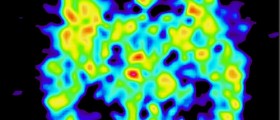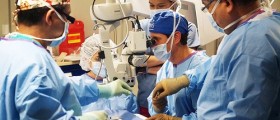
Syringomyelia is one of the most severe conditions affecting the spinal cord. It is characterized by formation of a cyst or cavity within the spinal cord. This cyst is medically known as syrinx. Once it develops, it cannot withdraw spontaneously. Instead it gradually expands causing irritation, compression and destruction of the spinal cord. As a result patients typically experience paralysis of different degree, weakness, stiffness in the back and changes in sensorium. Each and every patient develops an individuals set of symptoms and signs which all depend on the level of the spinal cord at which the syrinx forms.
According to statistical data syringomyelia affects 8.4 people per 100,000. The first symptoms occur in young adulthood and then progress gradually, leading to severe disability if the condition is left untreated.
Two Forms of Syringomyelia
Syringomyelia is either congenital or acquired. In the first case people are born with already formed syrinx while in case of acquired form of the disease syrinx develops some time after birth. Although syringomyelia typically affects the spinal cord there are cases when the cyst forms inside the brainstem. In such case the condition is classified as syryngobulbia, has more complex and severe symptoms and signs and basically interferes with one's breathing and heart's function.
When it comes to congenital form of the disease the most reported one is Arnol-Chiari malformation. The condition is characterized by bulging of the cerebellum into the neck portion of the spinal cord. Symptoms and signs occur each time there are sudden changes in the flow of cerebrospinal fluid. One of the frequent complications of this type of syringomyelia is hydrocephalus, accumulation of cerebrospinal fluid in the ventricle of the brain. Another potential complications is arachnoiditis, inflammation of the arachnoid membrane, one of three membranes that cover both the brain and the spinal cord.
As for acquired syringomyelia, it rarely develops spontaneously and is generally a complication of some trauma, inflammatory processes (meningitis, arachnoiditis) and hemorrhage or tumor occurring along the spinal cord. The cyst forms at the site of previous damage and starts to expand slowly. It may take years for the first symptoms to occur. When they do, patients may develop various set of health problems. For example, some complain about pain and weakness, others experience sensory impairment. Paralysis may occur as well even though it basically occurs once the syrinx has significantly damaged the spinal cord, in later stages of the disease.
Diagnosing Syringomyelia
The easiest way to confirm the presence of a syrinx is to perform magnetic resonance imaging (MRI) of the brain and the spinal cord. This imaging study gives perfect insight in the location of the syrinx, its size and relationship to surrounding spinal cord and spinal nerves. MRI can additionally confirm or rule out hydrocephalus (in case of syringobulbia). The exam may also reveal an underlying cause of syringomyelia such as tumors.
Another test that needs to be performed is electromyography (EMG). It will show to what extent are the affected muscles weak. Lumbar puncture measures the pressure of cerebrospinal fluid and if there is doubt about whether the person is actually suffering from syringomyelia there is one more test available. It is known under the name myelogram and includes injection of a contrast material (a special dye) into the subarachnoid space with subsequent X-ray evaluation (fluoroscopy).
Syringomyelia- Treatment Options
Conservative treatment is, unfortunately, ineffective in practically all patients suffering from syringomyelia. None of the available drugs can stop expansion of the syrinx or make the cyst completely disappear. Symptomatic therapy may help patients deal with symptoms and signs of the spinal cord irritation, compression or more severe damage but their effects are also not long-lasting. So the only way to help these patients is to surgically drain the syrinx (if possible) and to perform such surgery as soon as possible before the one develops permanent neurological sequelae.
However, not all the patients will undergo surgery. Doctors will evaluate the damage the cyst has caused and closely monitor disease progression. In spite of being the only definitive cure for syringomyelia, surgery of this type carries many risk and is associated with different potential complications. Because of that it is essential to estimate whether the surgery will actually help or the risk outcomes benefits in which case it is better not to be operated. The goal is to drain the cyst and reduce or completely eliminate compression and irritation of the surrounding spinal cord. In patients suffering from Arnold-Chiari malformation drainage of the syrinx allows the cerebellum to return into the skull. This way the flow of cerebrospinal fluid returns to normal.
In certain number of patients symptoms reoccur which requires repeated surgeries. Patients who do not undergo surgery are basically treated with analgesics. They most commonly require strong pain killer such as opioids that can be combined with medications efficient against neuropathic pain such as Neurontin. Muscle spasms are brought under control with trigger point injections.
All in all, the doctor is the one who will recommend the best treatment approach according to the severity of syringomyelia and the speed of its progression. He/she will make sure that patients receive therapy on time and have all their neurological functions preserved.








_f_280x120.jpg)



-Causes,-Symptoms,-Diagnosis,-Treatment_f_280x120.jpg)




Your thoughts on this
Loading...